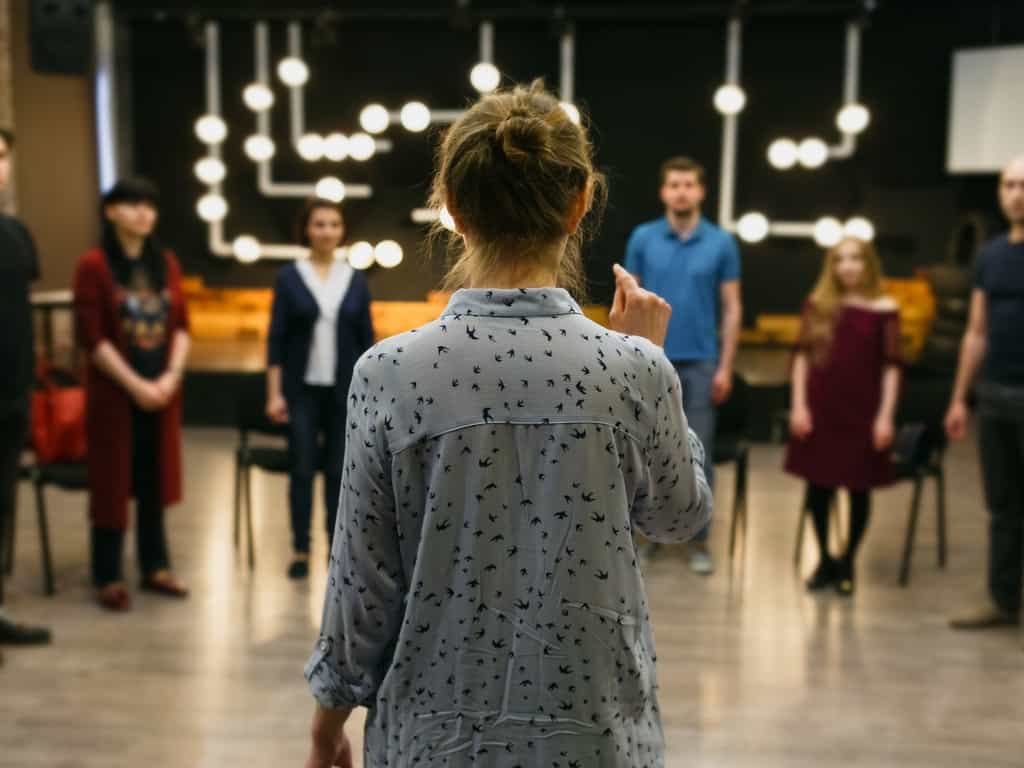Overcome by a Challenge? Forget about It and Go Play
Noted improv expert Janna Sobel joined us for a recent Disruptor Studio session to demonstrate how doing improv can help us access new ways of solving problems as we work to blow sh*t up on a daily basis. Janna knows what she’s talking about: she’s a graduate of The Second City’s Conservatory Program, where she’s now a faculty member teaching improv to children and teens.
If you’re a comedy fan, the words “Second City†doubtless ring a bell. The Second City justifiably calls itself the world’s premier school of comedy; among its alumni are some people you just might have heard of: Dan Aykroyd, John Belushi, John Candy, Stephen Colbert, Tina Fey, Bill Murray, Jordan Peele, Amy Poehler, and Joan Rivers. But laughter (think SCTV, Saturday Night Live, and the Upright Citizens Brigade) is just part of its legacy—and maybe not the most important part.
You see, The Second City continues the work of actress and social worker Viola Spolin, who invented improv during the Great Depression not to entertain but to serve immigrant children. As drama supervisor for the Works Progress Administration Recreation Project in Chicago, she created improvisational drama games to help children behave collaboratively and empathetically, even if they spoke different languages.
Eventually, her son, Paul Sills, asked an important question: “How might we take these games for children and apply them to adults, except put them on stage?â€

As author Sam Wasson explained in an interview with Wisconsin Public Radio, “Her son Paul takes his mother’s games for children, and he says, ‘Well, what if adults play these games on stage?’ And that could be a great way to convey the news of the day—just create instant theater for people and show people what their lives look like right now.â€
Sills answered his own question with a theater company that became The Second City in 1959. More than six decades later, the organization continues using the improv techniques Spolin created to facilitate play and learning for all types of audiences. They’ve even created an improvised caregiving model for healthcare workers.
Friends, we might not be in the middle of the Great Depression like Spolin was when she invented improv, but 2020 has been pretty depressing for a lot of folks. While the losses look different for each of us, we all grieve something we’ve missed this year and many of us struggle with the uncertainty that a pandemic brings.
Children are processing their stresses and fears by incorporating COVID-related themes into their everyday play. Experts say this is normal and healthy, especially for younger ones unable to verbally process their feelings.
As improv demonstrates, we can all benefit from play as we seek to overcome our obstacles. We don’t have to include children to enjoy play (although I highly recommend playing a card game like Throw, Throw Burrito or Exploding Kittens with the nearest kid). But whether we have kids around or not, we need to take a lesson from them to prioritize play in our daily routines.
Get Busy Playing
So as we close out the year and plan ahead for 2021, I encourage you to get busy playing for yourself, your family, and your team. Let The Second City inspire you to use play as a way to overcome obstacles. Whether those obstacles are mental, emotional, physical, financial, logistical, play your way through them.
Play is associated with all types of cognitive benefits; it has even spawned a national foundation that’s investigating and advocating for the importance of play through research. Play promotes creative problem-solving, enhances collaboration, and improves brain function. It even improves memory and stimulates growth of the cerebral cortex.
The why of play is clear. I understand, though, that if playing as an adult were, well, child’s play, we’d be playing more often.
So how do we shift our mindset to prioritize play? We need to rediscover it.
Discover the 5 Ws of Play and then Play 5 Ways
Kick it back old school to the 5 Ws: who, what, when, where, and how (yeah, how ends in a W): Who do you like to play with? What do you like to play? When, where, and how can you play?
Stuart Brown, MD is the leading authority on play for adults. He wrote the book on it. He also gave a TED talk, “Play is More Than Just Fun,†to explore the different types of play.
Here are his categories:
Rough-and-Tumble Play
Rough-and-tumble play develops physical, mental, and emotional mastery, including emotional regulation. Whether it’s tug-of-war, dodgeball, or a scavenger hunt, this style of play is both physical and emotional.
Body Play
Unlike rough-and-tumble play, body play gets us outside our normal “gravity,†as Brown defines it. Think adventure play like mountain biking, surfing, hiking, or riding roller coasters.
Ritual Play
This category involves any game with set rules or structures, from chess and board games to organized sports and group games. Ritual play forces us to create, strategize, and design while we bring different people together to achieve a common goal.
Imaginative Play
Improv fits in here, as does your favorite art project, cosplay, storytelling exercise, or anything else that causes your imagination to run wild and free.
Object Play
Object play involves manipulating objects, such as designing and building with materials like Lego bricks, Play-Doh, and Jenga blocks. Building forts and solving jigsaw puzzles are other examples of object play. This type of play helps children explore the function of objects and the use of tools to accomplish tasks. I’d say it can do the same for us.
Pick Your Play and Go To Work
Find the type of play that will engage you (or your team). Make sure it’s all play and no work, but mandate it if you must. (Thanks, Liz Lemon!)
Like you would for a workshop session or weekly update, seek feedback on what you play and always be improving it. Your creative team should have input, and so too should your HR and accounting teams—even if that means talking to Toby Flenderson and Kevin Malone.
If you’re working on yourself, spend a minute reflecting on what you liked or didn’t like about what you played. Then try something else or build on your experience.
Treat play the same way you would any other method for improving self or team: Make time for it, measure it (in a fun way if you can), and make time for it again. If you model play at work, you can be a role model for creativity and resilience.
Now, get to play!

LOving the idea that we focus on how we play and what we might be able to do. I assume the more areas we play in the better 🙂